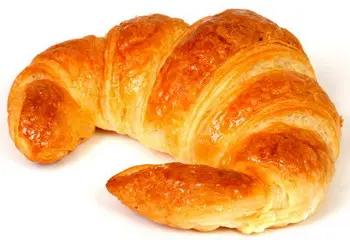This site uses only a few technical cookies necessary for its operation. By continuing to browse, you accept their use.
To find out more...
To find out more...
The beautiful story of the croissants

As you may have already noticed, cooking, baking and pastry-making are full of stories or legends, usually very romantic, about this or that product or recipe. This is often the case for named recipes, for example tarte tatin, peach melba, paris-brest and many others, but it also applies to very emblematic products of the bakery.
Well, here is the beautiful story of the "invention" of croissants.
Well, here is the beautiful story of the "invention" of croissants.
20 K 5/5 (19 reviews)
Keywords for this post:BakeryBakersMineViennoiserieVienneCroissantHistoryAustriansTurksMarie-antoinetteLast modified on: October 10th 2018
The beautiful story of the croissants

July 14, 1683, the Turks (at the time they were called "Ottomans") laid siege to Vienna for the second time. The city was, at the time, still fortified, and although it was the dawn of the Enlightenment, it was still a quasi-feudal attack that was being prepared: the Turks surrounded the city and cut off its supplies, thus hoping for a more or less rapid surrender of the Viennese.
It is a long siege war, but at the time already "mine" that is to say that the attackers not content with firing on the walls with cannons, dig galleries from their lines to the fortifications, and once arrived below fill with black powder and explode, hoping to create a breach in the walls and allow a rapid invasion.
The defenders are not idle, they dig galleries in the other direction, counter-mines, to try to eliminate the miners. To do this, they were listening, trying to detect the pickaxes of the Turkish miners' progression. Cleverly, the Turks decided to dig only at night, counting on the sleep of the Viennese to advance discreetly.
Bad luck for them, at night the bakers were at work, and in their bakeries they heard the miners digging, warned the authorities, who reacted to thwart the attack. The Viennese bakers saved the city from the Turk! (At least, that's the legend).
To celebrate this event, the bakers threw a small loaf of bread (probably brioche) in the shape of the crescent found on the Ottoman flag, this cake is called "hörnchen" ("little horn").

This same bun was brought to France with the arrival of the Arch-Duchess Marie-Antoinette, future wife of Louis XVI and Queen of France. Over time, and especially at the beginning of the 20th century, the original bun, under the influence of the French bakers, Parisian in particular, became something more sophisticated, both leavened and flaky, it is the croissant that we know today, of which only the original shape remains.

Nice story, isn't it?
That's also why we talk about viennoiseries, in France only, to group together everything that concerns leavened dough(brioche dough, bread pudding, brioche bread, etc.) and leavened leafy dough (croissant, pain au chocolat, raisin bread, etc.).
Note: You will often read or hear "The world, or the future, belongs to those who get up early", this is completely false, because if it were true the bakers would have been the masters of the world for a long time!
Lasts posts
Butter vs. grease
We often read in a recipe where a pastry is put into a mould that, just before pouring, the mould should be buttered or greased. But what's the difference between these 2 terms?December 1st 20251,3525
Getting out of the fridge early
Very often when you're cooking, you need to take food or preparations out of the fridge, to use them in the recipe in progress. There's nothing tricky about this: you just take them out of the fridge and use them, usually immediately, in the recipe. But is this really a good method?November 24th 20251,2615
Who's making the croissants?
When you look at a bakery from the outside, you naturally think that in the bakery, the bakers make the bread, and in the laboratory, the pastry chefs make the cakes. It's very often like that, with each of these professions having quite different ways of working, but sometimes there's also one...November 23th 20251,144
Oven height
When we put a dish or cake in the oven, we naturally tend to put it on the middle shelf, and that's what we usually do. But in some cases, this position and height can be a little tricky, so let's find out why.October 8th 20253,1725
The importance of sieving
In recipes that use a fine powder (flour, powdered sugar, etc.), you'll often see the advice to sift before using it. To sift is to pass the powder in question through a sieve (a very fine strainer) before incorporating it into your recipe. It's often advice, but is it really useful?September 3rd 20257,8283
Other pages you may also like
Fruits which can ruin your jelly
There are many ways of making a fruit mousse, but one of the simplest is to prepare a fruit jelly (basically a fresh fruit coulis with gelatine) and then mix this jelly before it sets completely with whipped cream. The result is perfect for filling a charlotte, for example. But do beware;...March 6th 201379 K4.0
What is the difference between bakery and patisserie?
This is a question that you may well have asked yourself and which I will attempt to answer. In France the two trades of "boulangerie" (bakery) and "pâtisserie" (patisserie and confectionery) have always been quite distinct, but where exactly do the boundaries lie? .February 7th 2017134 K 14.1
A few tips for effective kneading at home
When you have to knead dough for bread or some other recipe, you may well use a food processor or the type of machine known as a stand mixer. The best-known brands are Kenwood and KitchenAid. They are useful tools, but here are a few tips to help you get the best out of them.June 23th 2021284 K 23.8
The window-pane test in bread-making
The home bread-makers often ask themselves “Have I kneaded my dough long enough?” . A good question, as dough that is insufficiently kneaded will not rise properly or will fall flat when the top is slashed, which is very frustrating. To know when the dough is ready, one can rely on the length...June 16th 202197 K 23.9
The 3 kinds of meringue
Meringue – what could be simpler? Just beaten egg whites with sugar added. This makes a fairly stiff mixture which can then be cooked in a cool oven to create those lovely, light confections. But in the world of professional patisserie, meringue comes in three different kinds. Even if the...June 14th 201365 K4.5
Post a comment or question
Follow this page
If you are interested in this page, you can "follow" it, by entering your email address here. You will then receive a notification immediately each time the page is modified or a new comment is added. Please note that you will need to confirm this following.
Note: We'll never share your e-mail address with anyone else.
Alternatively: you can subscribe to the mailing list of cooling-ez.com , you will receive a e-mail for each new recipe published on the site.









